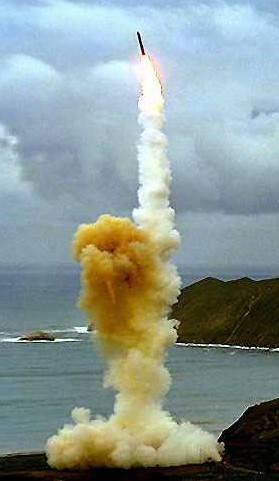|
|
Q 'n A
Answers To Your Questions
SPACE TODAY ONLINE ~~ COVERING SPACE FROM EARTH TO THE EDGE OF THE UNIVERSE
Q. What's the difference between a missile and a rocket? — Rusty B.
A. Missiles and rockets are the same. It's their usage that varies.
We speak of rockets used as weapons as missiles. A ballistic missile is a rocket that flies to a high altitude by firing its engines until all fuel is expended and then lets gravity drop its warhead payload onto a pre-planned target. It is a ground-to-ground weapon.
A similar rocket, if powerful enough, can be used to blast a satellite up to such a high altitude above the atmosphere that it will be in orbit around Earth. The satellite payload will stay up there for a period of time and then fall back down into the atmosphere and burn up.
Rockets used as military missiles are categorized by their ranges. Here are the types:
- BSRBM is a battlefield short range missile capable of a very short flight of less than 100 miles.
- SRBM is a short range ballistic missile that travels from 100-500 miles. An example is the Russian SCUD missile, which has been exported to more countries than any other type of guided ballistic missile. Iraq fired 93 SCUDs during the Persian Gulf War in 1991. North Korea produced a version of the SCUD it called Hwasong.

Launch of a Minuteman ICBM
USAF photo |
- MRBM is a medium range ballistic missile that travels from 500-1500 miles. Iran's Shahab-3 missile has a range of 800 miles, which makes it an MRBM. It was derived from North Korea's No-dong missile as was Pakistan's Ghauri missile.
- IRBM is an intermediate range ballistic missile that can hit a target 1,500-3,400 miles away. IRBMs frequently have been turned into launchers for small satellites. This is accomplished by adding upper stages to the rocket so it is more powerful. For example, during the early days of space launches in in the United States, the Thor, Redstone and Jupiter missiles were turned into space rockets. A modified Jupiter known as Jupiter-C launched America's first satellite, Explorer 1. Other examples of IRBMs turned into space launchers include Israel's Shavit and North Korea's Taep'o-dong.
- ICBM is an intercontinental ballistic missile that can strike a target 3,400 to 9,200 miles away. That makes it a global weapon. An ICBM has two or more rocket stages and flies up as high as 700 miles before dropping its warhead payload on a target. The United States, Russia, and China have operational ICBM warfare systems. Other nations, including India, Pakistan, Iran, Israel and North Korea, may have ICBMs, but not organized systems. Some examples of American ICBMs include Atlas, Titan, Minuteman and Peacekeeper. Recently, American Titan and Minuteman ICBMs, and Russian SS-9 Cyclone ICBMs, have been converted into space rockets.
BEATING SWORDS INTO PLOWSHARES
- SLBM is a submarine launched ballistic missile that can deliver a nuclear weapon payload. An example of an SLBM is the United States' Trident intercontinental ballistic missile, which is armed with nuclear warheads and launched from submarines. Russia's Shitl space rocket was derived from the SS-N-23 SLBM.
SUBMARINE NOVOMOSCOVSK LAUNCHES SATELLITES
 Ask Space Today Online another question Ask Space Today Online another question
 Return to the Questions 'n Answers main page Return to the Questions 'n Answers main page
|

 Ask Space Today Online another question
Ask Space Today Online another question